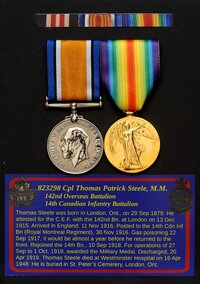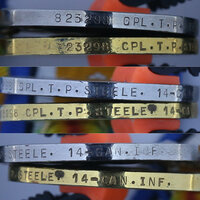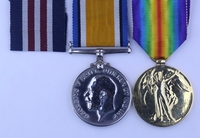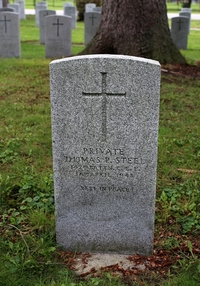
823298 Pte Thomas Patrick Steele, M.M.
142nd Canadian Overseas Battalion
14th Canadian Infantry Battalion
By: Capt (ret'd) Michael M. O'Leary, CD, The RCR
Thomas Patrick Steele was born in London, Ont., on 29 Sep 1879. He was the second of eight children born to Thomas Steele and Eliza Bray between 1877 and 1894. The family appears in the 1891 Canadian census of London. Led by parents Thomas (48) and Eliza (36), there are six children in the home: Joseph H. (15), Thomas P. (12), John (10), Maud (7), William (5), and Henry (2).
In the 1900 edition of a London city directory, Thomas P. Steel (sic), labourer, is shown to be living at 184 Maitland St., London, Ont. Also living at the address were Eliza (widow of Thomas), John J., and Joseph H., with both brothers having their trade shown as labourer.
Steele also appears in the 1901 Canadian Census. At the age of 23, he is shown in a family group with Mary A. Steele (31) and children Annie L. (age 7, b. 25 Dec 1893), Francis P. (age 4, b. 18 Nov 1896), and Thomas J. (age 1, b. 29 Sep 1899).
The Baptismal Register of St. Peter's Cathedral, City of London, has an entry dated 5 Apr 1901 for the baptism of Thomas Joseph Steele. The entry, signed by J.T. Aylwood, Priest, reads: "I, the undersigned, have baptized Thomas Joseph, born in London on Sept. 10th, 1899 from the lawful marriage of Thomas Steele of London and May Ann Selby of London."
Searches for the other two children in the household reveals a complex family story. "Annie L." appears in the Baptismal Register of St. Peter's Cathedral, City of London. Her entry, dated 29 Mar 1894, reads: "I, the undersigned, have baptized Anny Louisa, born in London, Ont., on Dec. 16th, 1893 from the lawful marriage of Mr. Bert Simpson of London and May Ann Selby of London" was signed by M. McCormack, Priest. Francis Paul appears in the birth records for Essex County. He was born 18 Nov 1896, and is identified as the son of George Munroe, a Windsor basket maker, and Mary Ann Selby.
Digging deeper into Mary Steele's story reveals that she married Alfred Garner, a farrier and horse trainer, at London, Ont., on 24 Dec 1885. Mary is shown in the 1891 Canadian census living with her mother Catherine and brother Thomas. Also in the household is 5-year-old Ella May Garner. Searches for later appearances of Alfred or Ella Garner have led to no confirmed connections for their fates. There is also no clear evidence of what happened to Bert Simpson or George Munroe before Mary began sharing her household with Thomas Steele by 1898-99, i.e., before the birth of Thomas J.
Thomas and Mary's daughter Gertrude Hazel was born in London, Ont., on 23 May 1902. She was baptized at St. Peter's Cathedral on 10 Jul 1902.
The Steele family appears in the 1911 Canadian census. Mary (42) and Thomas (32) are shown with six others in the house. These are Frank (15), Thomas (11), Hazel (9), Thomas' brother Harry ("Henry," 22), Pearl (17, Harry's wife), and Ella (2). Steele's trade is given as malster (i.e., maltster, or brewer) and son Frank was working as a cigar maker. Pearl was also working in the cigar trade and Harry was a labourer.
Thomas Steele attested for service in the Canadian Expeditionary Force (C.E.F.) with the 142nd Overseas Battalion at London, Ont., on 13 Dec 1915. A 36-year-old labourer, he was described on his attestation paper as 5 feet 5 inches tall, weighing 142 pounds, with a 35 1/2-inch chest, a ruddy complexion, blue to grey eyes, and dark brown hair. His religious denomination was Roman Catholic. Steele identified his wife, Mary Steele, 17 York St., London, Ont., as his next of kin. On attesting with the 142nd Battalion, Steele was given the service number 823298.
On 27 Jan 1916, events in Steele's life took place that also helps to untangle the story of his family situation. On that day, Thomas Patrick Steele (age 36), bachelor and labourer, originally of Ingersoll, Oxford County, married Mary Garner (age 45), widow, of London, Ontario, where she had resided since the year 1899. Their marriage, probably solemnized to ensure Mary's entitlement to Separation Allowance once Thomas left the country with the C.E.F., confirmed that although they had been living together for years as husband and wife, they had not been married. Notably, the marriage certificate also shows that Mary's legal surname was that of her first husband, establishing that her other children had been born out of wedlock despite being recognized as legally married for their respective baptisms.
Steele's battalion, the 142nd (London's Own) Battalion, C.E.F., was based in London, Ont., where the unit began recruiting in late 1915. After sailing from Canada on 1 Nov 1916 aboard the S.S. Southland, the battalion was absorbed into the 23rd Reserve Battalion, C.E.F. on 11 Nov 1916 when it arrived in England.
Commencing November, 1915, Steele established a monthly Pay Assignment of $20 to be sent to his wife. As a Private in the C.E.F., Steele was paid $1.00 per day plus an additional ten cents daily field allowance. His pay assignment represented about two-thirds of his monthly pay. Mary Steele also received $20 monthly Separation Allowance, which began in March, 1916. The amount of separation allowance would increase to $25 per month in December, 1917, and to $30 in September, 1918arge to Canadian Convalescent Hospital."
By 12 Nov 1917, Steele's condition was considered improved enough for transfer to the 500-bed capacity Canadian Convalescence Hospital at Hillingsdon House, Uxbridge. He was duly passed to this facility and the notes recorded at the time of his transfer stated "Still has cough."
During Steele's hospitalization, telegrams were sent to his family to inform them of his condition. On 11 Nov 1917, the first cable read "Mil. Hosp. Richmond, suffering from gas poisoning." Two days later a second cable followed "Doing very well, Can. Conv. Hosp., Uxbridge, Kent."
At the Canadian Convalescence Hospital in Uxbridge, the detailed recording of Steele's condition continued:
- 19 Nov 1917: "Cough is sharp and irritating."
- 29 Nov 1917: "Cough some improved."
- 11 Dec 1917: "Still has bad cough. Transferred to Epsom."
On discharge from the Convalescent Hospital, Uxbridge, Steele's case notes read: "Still has cough. Transferred to Manor War Hosp., Epsom." This transfer was caused by the Uxbridge property being taken over by the Air Ministry and Hillingdon House closing as a medical facility.
On 12 Dec 1917, Steele was admitted to Manor City of London War Hospital, Epsom. Case notes at Manor War Hospital, dated 6 Jan 1918, read: "Admitted here convalescing from gas poisoning. Complains of indigestion and pain in epigastrum. Nothing abnormal found in abdomen. Lungs negative. Heart negative. Should be fit for active service within six months. Transferred to Woodcote."
Steele was admitted to the Military Convalescent Hospital, Woodcote Park, Epsom, on 15 Jan 1918. His Medical Case Sheet noted his condition: "Disease, Gas Poisoning. Gassed in Sept. Chief Complaints – Pains in stomach, chest and eyes, cough, but no expectoration. Has been having indigestion since Sept. Physical Examination – Eyes inflamed. Lungs show rales at both apicies and over bases. Heart negative." By 23 Jan 1918, his case notes read: "Complains of pains in belly. Gram. neg. Has done P.T.!! here. 23.1.18 Fit for D 1/1." (The latter is likely a notation for the medical category subgroup for "other ranks of any unit under medical treatment, who on completion would rejoin their original category.")
On 28 Jan 1918, Steele was discharged from hospital and placed "On Command," a temporary assignment without change of parent unit, to No. 2 Canadian Convalescent Depot (C.C.D.), Bramshott. This was a facility where soldiers could recover from wounds and rebuild their strength. Three weeks later, on 22 Mar 1918, Steele ceased to be attached to 2 C.C.D. on return to the 23rd Res. Bn. where he remained for over five months.
Almost a year after his evacuation from France for gas poisoning, Steele joined a new reinforcement draft for France on 5 Sep 1918 and was returned to the 14th Battalion. Moving quickly through the rear areas, he arrived at the C.B.D. on 6 Sep 1918. Three days later he passed through the Canadian Corps Reinforcement Camp (C.C.R.C.) and rejoined the 14th Battalion in the field on 10 Sep 1918.
The 14th Battalion was in Billets at Berneville from 4 to 19 Sep 1918. After suffering losses of over 250, killed, wounded, and missing, in the fighting at the Drocourt-Queant Line during 2-3 Sep 1918, the unit was in need of a chance to absorb reinforcements and reorganize.
Marching out of Berneville on 19 Sep 1918, the 14th Bn. moved into old trenches at Telegraph Hill for a few days. They moved again on 24 Sep 1918, marched to Arras, then entrained to Bullecourt. Another march took the unit into the forward lines, relieving the 18th Battalion in Buissy Switch on the night of 25 Sep 1918. This was to be the assembly position in preparation for the Battle of the Canada du Nord and the battalion's role in the Capture of Bourlon Wood.
After spending the 26th making arrangements for an attack, the 14th Battalion, supported by tanks, jumped off at 5.20 a.m. on 27 Sep 1918. The unit War Diary records the actions of the day:
"BUISSY SWITCH – Sept. 27th
"There was considerable gas shelling on the way in, but no casualties. The 16th Canadian Battalion were holding assembly area, but were not very familiar with ground, as they had taken ever from the 2nd Division only the night before, The 16th Battalion rendered valuable assistance during our assembly, and left a platoon in PAVILAND WOOD to deal with a machine gun nest. Posts were established to cover assembly ma the area reconnoitred; Dykes and several rows of wire were discovered at the eastern edge of the wood. Information received from the Intelligence regarding this area proved to be very inaccurate. Bridges and rafts to be used in crossing the canal and dykes did not arrive.
"The Battalion attacked at dawn. Objectives, CANAL DU NORD, SAINS LEZ MARQUION, and trench system to the east, The barrage opened at 5.20 a.m, and the Battalion began the attack of the famous CANAL DU NORD and MARQUION lines, The Canal was crossed at 5.45 a.m., and the attack was well launched, both officers and men did wonderful work, Recommendations are submitted for officers and men who particularly distinguished themselves. The final objective was reached at 7.30 a.m., and the Battalion consolidated on a two-company frontage."
The cost to the battalion was heavy, with the Commanding Officer's report in the War Diary noting over 200 killed, wounded, and missing. In balance, the 14th Battalion captured approximate 50 German machine guns, a number of trench mortars, and an anti-tank rifle in addition to 450 prisoners of war.
Four days later, on 1 Oct 1918, the 14th Battalion went over the top again in another assault on German positions.
"SOUTH-WEST of CAMBRAI-DOUAI RD. Near SAUCOURT – Oct 1st.
"The 14th Canadian Battalion assembled in depth on a one Company frontage immediately south west of the CAMBRAI–DOUAI Road facing the village of SAUCOURT. The assembly was made under very unfavourable circumstances, It rained heavily during the night, and the country in vicinity of the assembly area was a maze of mud, shell-holes and wire. There had been no opportunity for a preliminary reconnaissance and the guides had lost their way. Notwithstanding those difficulties the assembly was completed in good time. Waiting for ZERO is always very trying, still, despite the rain, cold and the fact that there was no rum issue, the spirit of the men was excellent. The Battalion attacked at 5.00 a.m. with 13 Officers and 375 other ranks."
A lengthy and detailed report by the Commanding Officer attached to the War Diary for the month of October, 1918, describes a costly, confusing and ultimately unsuccessful assault by the 14th Battalion. Despite the best efforts of all ranks, losses of means of communications and artillery support compounded the problems of losses throughout the units chain of command and stymied efforts to gain and hold ground. By the end of the day, platoons and companies in the unit were led by non-commissioned officers, from the few remaining to fill those roles. The C.O. noted in his report:
"Too much cannot be said in praise of the Non-Commissioned Officers who so successfully handled their platoons, and in two cases, companies throughout the entire day's operation, but unfortunately in rendering these excellent services many of them have become casualties."
The 14th Battalion left the Cambrai area on 5 Oct 1918 to the Viz-en-Artois area. Four days later, on 9 Oct 1918, Steele was sent On Command to the C.C.R.C. While at the reinforcement camp, he was appointed Lance Corporal on 15 Oct 1918.
On 23 Oct 1918, the 14th Bn. moved into billets at Fenain. The battalion would remain here until the end of the war. Steele's name appears in the battalion War Diary during this period. On 10 Nov 1918, the day before the war ended, the War Diary entry included:
"The following decorations were awarded to the undernoted other ranks of the battalion for gallant conduct in the field, in the operations of Sept. 27th to Oct. 1st, 1918."
"Military Medal – 823298 Pte. Steele, T.P.
Steele returned "Off Command" to the 14th Battalion on 17 Nov 1918. Three months later, on 14 Feb 1919, while the unit was at Huy, Belgium, he was promoted to the rank of Corporal
On 14 Mar 1919, after a week at Le Havre, the 14th Battalion began its journey back to Canada. The War Diary notes:
"LE HAVRE – March 14th.
"The Battalion paraded at 1300 hours at very short notice and marched to the wharf, embarking on the S.S. QUEEN ALEXANDRA about 1500 hours. Owing to shortness of notice a few men were left behind and the Battalion embarked 30 Officers and 653 Other Ranks. The ship sailed at 1620 hours (French time). The weather was good and the Channel comparatively smooth. Anchored off WEYMOUTH at 2300 hrs. (English time)
"BRAMSHOTT – March 15th.
"The S.S. QUEEN ALEXANDRA moved into the quay at 0900 hours and the Battalion disembarked immediately and were served with a hot meal. Before entraining each man received a bag containing a substantial cold meal. The Battalion left WEYMOUTH at 2100 hours arriving at LIPHOOK about 1500 hours where hot tea and cakes were served. After a short march BRAMSHOTT CAMP was reached, the Battalion being allotted to "D" Wing in the south part of the Camp. A hot meal was in readiness and everyone soon settled down in their new quarters. From the time of landing in WEYMOUTH to settling down in BRAMSHOTT the Battalion was handled expeditiously and with every regard to the men's comfort and well being. Nothing but the highest praise can be given to those in charge of the arrangements."
The battalion's last War Diary entry was recorded on 9 Apr 1919:
"BRAMSHOTT – April 9th.
"The official orders for the embarkation of the Battalion on the S.S. CARMANIA to-morrow were received with keen delight by all. The Battalion is to parade at 2330 hrs. to-night, entraining at 0120 hrs., breakfast is to be had at CREWE at 0820 hrs. and it is expected to reach RIVERSIDE at 1000 hrs. where embarkation is to take place immediately. Everything possible is being done to make the trip as comfortable and enjoyable as can be. Needless to say all ranks are eagerly looking forward to the arrival in Montreal of the Royal Montreal Regiment after so long an absence from their native heath."
Steele, along with others in the battalion, were taken on the strength of No. 4 District Depot, Montreal, on sailing from England. He disembarked at Montreal on 18 Apr 1919 and two days later, on 20 Apr 1919, was discharged from the C.E.F. on demobilization.
On discharge, Steele was issued the Class "A" War Service badge numbered 270176. He was also eligible to receive a War Service Gratuity of $420. Mary Steele received a spousal amount of $180. Cheques were issued to them in five instalments between May and September 1919.
The award of Steele's Military Medal was formally published in the London Gazette, Issue No. 31430, dated 3 Jul 1919 and was entered in his service record on 9 Aug 1919.
After two and one-half years overseas, Steele's family was struck by tragedy eight months after his return home. On 13 Dec 1919, The London Advertiser published an obituary notice for Mary Steele:
"Death of Mrs. Steele
"Mrs. Mary Steele died Friday [12 Dec 1919] at St. Joseph's Hospital after a short illness, in her 51st year. She is survived by her husband, Thomas Steele, one son Frank, and one daughter, Mrs. L. Kipp, both of this city.
"The funeral will be held on Monday morning from the family residence, 17 York St., to St. Peter's Cathedral at 9 o'clock. Interment will be made in St. Peter's cemetery."
Frank (Francis Paul) Steele was Mary's son by George Munroe although he had taken Thomas Steele's surname. Frank also served in the C.E.F. during the First World War. He had enlisted with the 33rd Overseas Battalion at the age of 19, service number 400851. Once overseas, he joined the 58th Canadian Infantry Battalion as a reinforcement in September, 1916. Frank achieved the rank of Sergeant while with the 33rd Bn., reverted to Private to go to France, and was briefly an Acting Corporal with the 58th Bn. (reverting once again, at his own request). In October, 1916, he was wounded, suffering a gun shot wound of the left thigh. After recovering from his wound, Frank returned to France to join the 4th Canadian Mounted Rifles in November, 1917. With this unit he rose to the rank of Sergeant in July, 1918. Frank was wounded again (shot wound, chest) in September, 1918. He would not return to his unit and would be discharged at London, Ont., on 8 Apr 1919. At the end of the war, Frank Steele was awarded the French Croix de Guerre to accompany the service medals he would receive, the British War Medal and the Victory Medal. Frank died on 27 Feb 1956 at Hamilton, Ont.
Thomas's younger brother Henry "Harry" John Steele also served in the C.E.F. Claiming prior service of two years with the 1st Hussars (London, Ont.), he signed an attestation form for the 33rd Overseas battalion on 13 Jan 1915 (#558). No other document in his service record refers to this enlistment. His name next appears in The London Advertiser on 11 Sep 1915 which includes "Henry John Steele" as a new enlistee for the 70th Battalion at London. Again, there is no followup evidence that he remained with this unit. Finally, he enlisted with the 142nd Overseas Battalion on 10 Dec 1915 (#823203). Henry Steele landed in England on 11 Nov 1916 and was taken on the strength of the 14th Canadian Infantry Battalion on 30 Nov 1916. Eleven months later, on 31 Oct 1917, he suffered a G.S.W. (gun shot wound) caused by shrapnel to his right hand. After spending months in hospital while the medical staff combated the severe infection of his wound, it was confirmed that the partial loss of function of his hand made him unfit for further military service. Henry Steele was invalided to Canada in May 1918 and discharged, medically unfit, on 7 Aug 1918. He dies at London, Ont., on 26 Jul 1946.
The surviving daughter mentioned in Mary Steele's obituary notice was Hazel Gertrude. She married Charles Llewellyn Kipp on 11 April 1919, and was the first of Kipp's three wives. Kipp had served in the C.E.F., proceeding overseas with the 4th Draft from the 1st Depot Battalion, Western Ontario Regiment, and serving in England (#2355305). The couple were living in Detroit, Michigan, at the time of the birth of their son in August, 1924. Hazel died in Detroit on 10 Dec 1933.
For his service in the C.E.F., in addition to his Military Medal, Thomas Steele was entitled to receive the British War Medal and the Victory Medal. These were despatched to him at 17 York St., London, Ont., on 5 Sep 1929.
Thomas Steele died at Westminster Hospital, London, Ont., on 16 Apr 1948. The cause of his death was recorded as pulmonary edema due to cardio renal disease and hypertension. Steele was buried in St. Peter's Cemetery, London, Ont. (grave #9, Lot 30, Sect. C).
Pro Patria
Visit a randomly selected page in The O'Leary Collection (or reload for another choice):
- The O'Leary Collection; Medals of The Royal Canadian Regiment.
- Researching Canadian Soldiers of the First World War
- Researching The Royal Canadian Regiment
- The RCR in the First World War
- Badges of The RCR
- The Senior Subaltern
- The Minute Book
- Rogue Papers
- Tactical Primers
- The Regimental Library
- Battle Honours
- Perpetuation of the CEF
- A Miscellany
- Quotes
- The Frontenac Times
- Site Map
QUICK LINKS
The O'Leary Collection—Medals of The Royal Canadian Regiment
Newest additions:
![]()
![]() SB-12725 Private Henry "Hank" Ard
SB-12725 Private Henry "Hank" Ard ![]()
WIA at Hill 187, Died of Wounds in Japan
![]()
![]() 2355331 Lance Corporal Albert Lorking
2355331 Lance Corporal Albert Lorking
Wounded in action, later a War Amps representative.
![]()
![]() 4334 / 477996 Pte Isaac Hamilton Wilcox
4334 / 477996 Pte Isaac Hamilton Wilcox
Permanent Force, South Africa, and C.E.F.
![]()
![]() 477019 Private Harold Ashcroft
477019 Private Harold Ashcroft
Transferred to the Tunnelers.
![]()
![]() 734231 Private Clark D. Thompson
734231 Private Clark D. Thompson ![]()
The older Thompson brother, killed in action.
![]()
![]() 733849 Private Norman Parker Thompson
733849 Private Norman Parker Thompson
The younger Thompson brother; post-war service in the Special Guard.
![]()
![]()
![]() A305 / 400305 Private Andrew Walker
A305 / 400305 Private Andrew Walker ![]()
"Previously reported Wounded, now Killed in Action."
![]()
![]() 823298 Pte Thomas Patrick Steele, M.M.
823298 Pte Thomas Patrick Steele, M.M. ![]()
… for gallant conduct in the field …
![]()
![]() P13066 Sergeant Harold Thompson
P13066 Sergeant Harold Thompson
Instrumental Soloist for over 20 years of Canadian Army service.
![]()
![]() 9609 / 477728 Private Albert Edward Piper
9609 / 477728 Private Albert Edward Piper
"Arrived from England as a STOWAWAY …"





